We've been hearing about the Hybrid Memory Cube alternative to today's RAM for a while now, and we have to say that it was about time the specification got published.
This isn't the final form of the specification, just an initial draft but, even so, it describes an interface protocol and short-reach interconnection across PHYs (physical layers) targeted at high-performance industrial, networking, and test and measurement application, although it can essentially replace any DDR3 RAM (random access memory).
For those interested in the technical details, Hybrid Memory Cube, jointly designed by Micron and Intel, is about 7 times less power-hungry than DDR3, but capable of 1 Tb/s data rates. The name comes from the stacked memory chips, which look like a cube.
HMCC wishes to eventually replace today's random access memory in everything from servers and PCs (desktops, notebooks, ultrabooks) to TVs and even portable consumer electronics (tablets, smartphones, etc).
“The progress that’s been made on the HMC specification is extremely exciting to Xilinx because of the increasingly important role that our 28nm high-performance, low-power FPGAs are playing in high-performance systems,” said Hugh Durdan, vice president of portfolio and solutions marketing at Xilinx.
HMCC intends to have the final draft of the HMC specification ready by the end of the current year, 2012. It also hopes that more companies will join the consortium and participate in finalizing and perhaps enhancing the technology.
“With the draft standard now available for final input and modification by adopter members, we are excited to move one step closer to enabling the Hybrid Memory Cube and the latest generation of 28nm FPGAs to be easily integrated into high-performance systems,” said Rob Sturgill, architect, at Altera.
“The steady progress among the consortium’s member companies for defining a new standard bodes well for businesses who would like to achieve unprecedented system performance and bandwidth by incorporating the Hybrid Memory Cube into their product strategies.”

 14 DAY TRIAL //
14 DAY TRIAL //